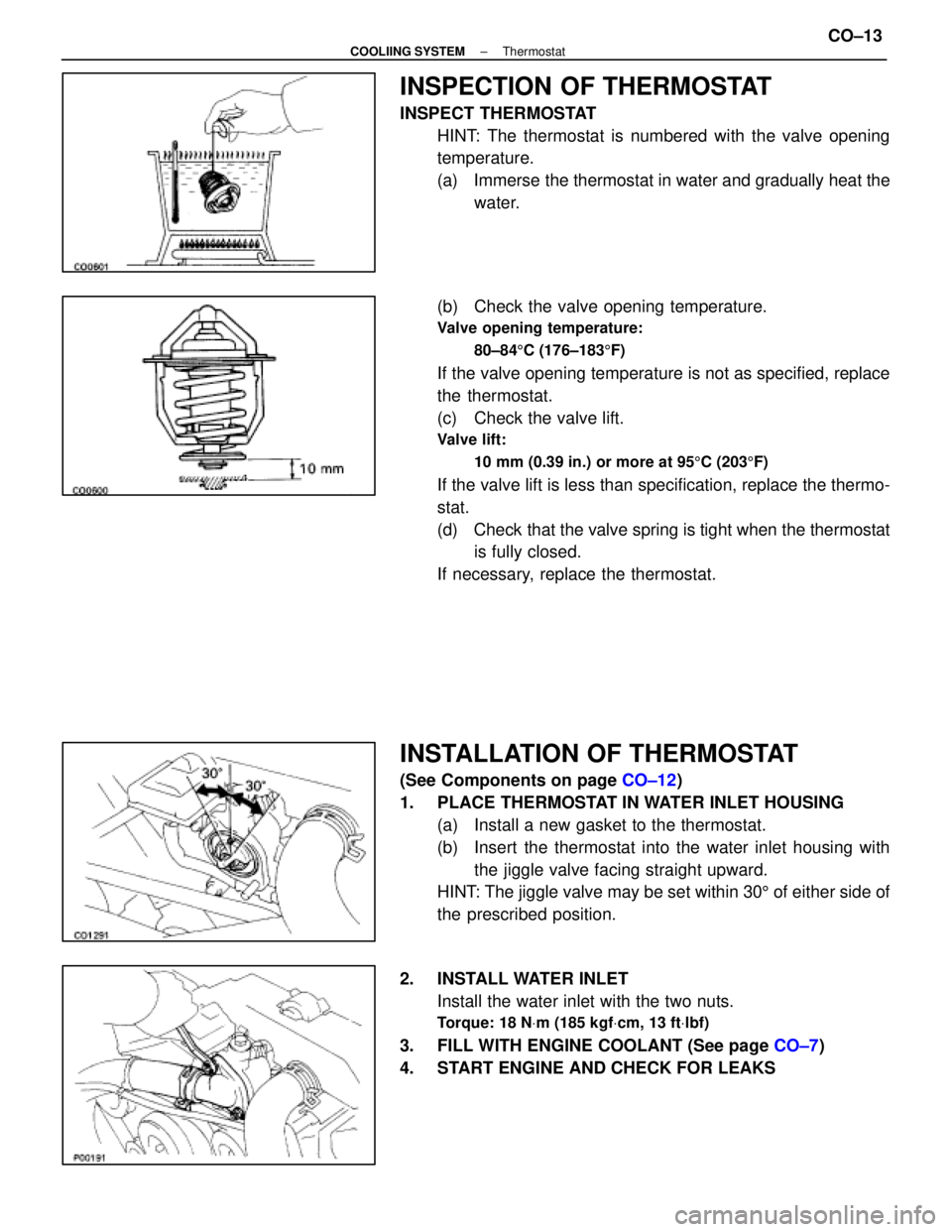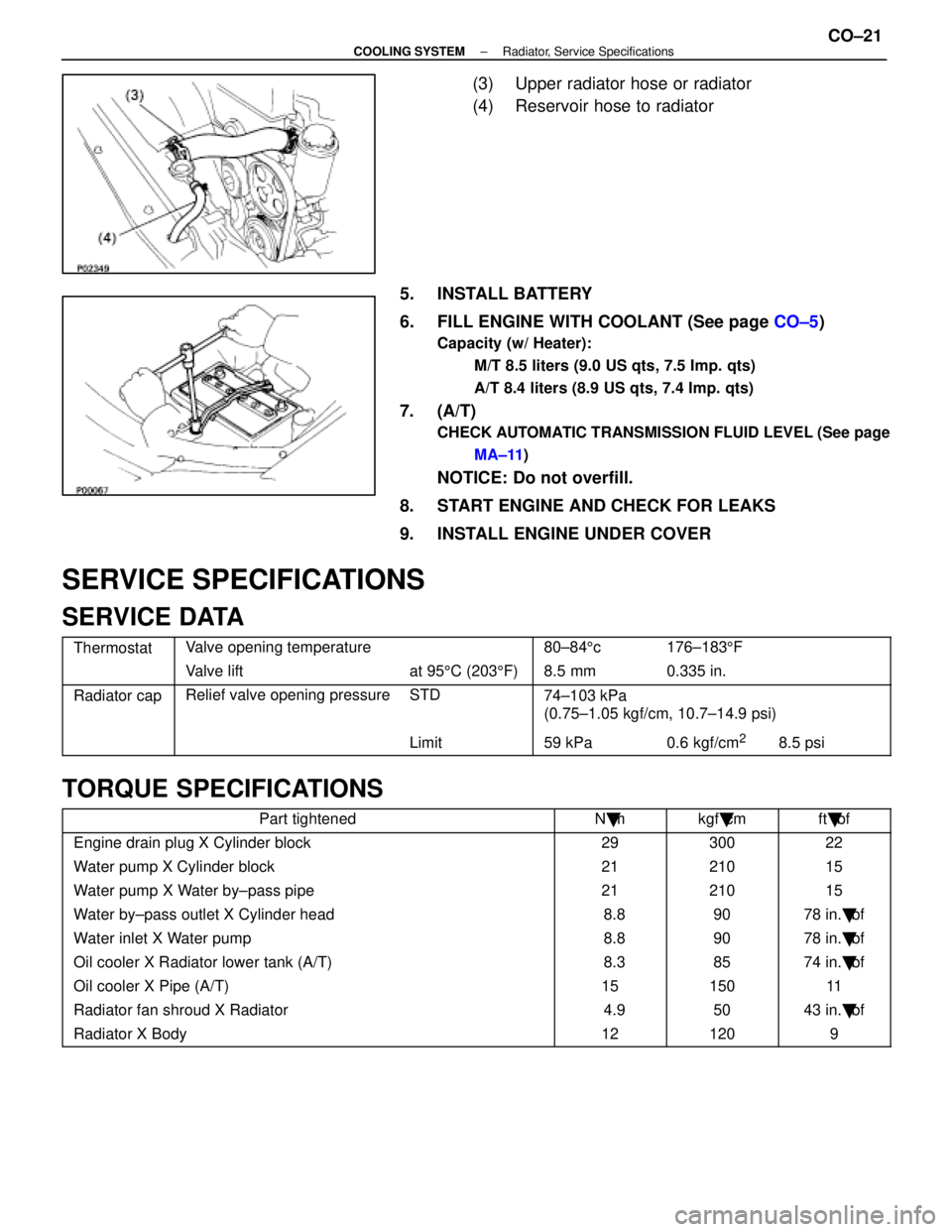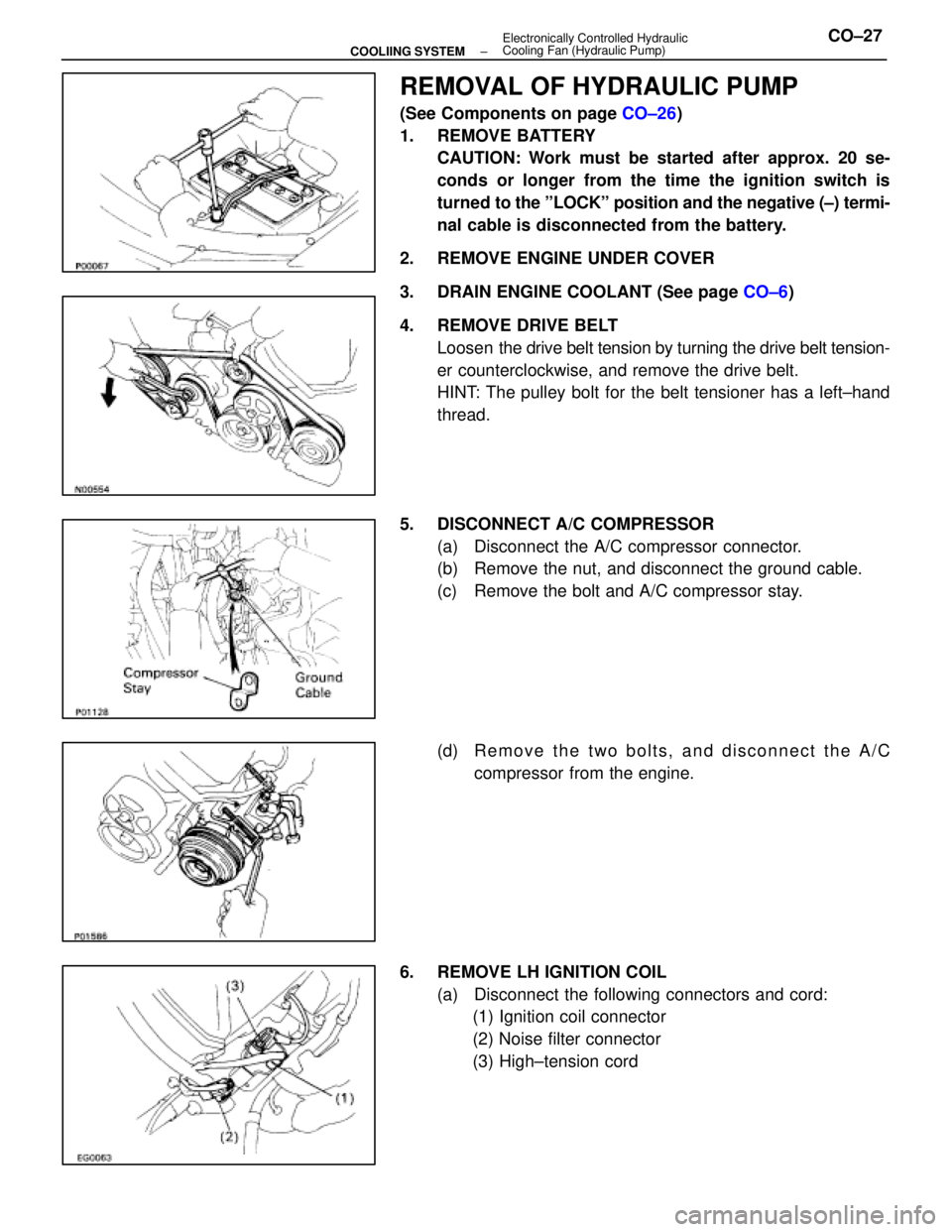Page 1273 of 4087
THERMOSTAT
HINT: Removal of the thermostat would have an adverse ef-
fect, causing a lowering of cooling efficiency. Do not remove
the thermostat, even if the tends to overheat.
COMPONENTS FOR REMOVAL AND
INSTALLATION
REMOVAL OF THERMOSTAT
1. DRAIN ENGINE COOLANT (See page CO±6)
2. REMOVE THERMOSTAT (a) Remove the two nuts holding the water inlet to the inlethousing, and disconnect the water inlet from the inlet
housing.
(b) Remove the thermostat.
(c) Remove the gasket from the thermostat.
CO±12
±
COOLIING SYSTEM Thermostat
WhereEverybodyKnowsYourName
Page 1274 of 4087

INSPECTION OF THERMOSTAT
INSPECT THERMOSTATHINT: The thermostat is numbered with the valve opening
temperature.
(a) Immerse the thermostat in water and gradually heat thewater.
(b) Check the valve opening temperature.
Valve opening temperature: 80±84 5C (176±183 5F)
If the valve opening temperature is not as specified, replace
the thermostat.
(c) Check the valve lift.
Valve lift:
10 mm (0.39 in.) or more at 95 5C (203 5F)
If the valve lift is less than specification, replace the thermo-
stat.
(d) Check that the valve spring is tight when the thermostat
is fully closed.
If necessary, replace the thermostat.
INSTALLATION OF THERMOSTAT
(See Components on page CO±12)
1. PLACE THERMOSTAT IN WATER INLET HOUSING (a) Install a new gasket to the thermostat.
(b) Insert the thermostat into the water inlet housing withthe jiggle valve facing straight upward.
HINT: The jiggle valve may be set within 30 5 of either side of
the prescribed position.
2. INSTALL WATER INLET Install the water inlet with the two nuts.
Torque: 18 N Vm (185 kgf Vcm, 13 ft Vlbf)
3. FILL WITH ENGINE COOLANT (See page CO±7)
4. START ENGINE AND CHECK FOR LEAKS
±
COOLIING SYSTEM ThermostatCO±13
WhereEverybodyKnowsYourName
Page 1275 of 4087

RADIATOR
CLEANING OF RADIATOR
Using water or a steam cleaner, remove any mud and dirt
from the radiator core.
NOTICE: If using a high pressure type cleaner, be careful
not to deform the fins of the radiator core. If the cleaner
nozzle pressure is 2,942±3,432 kPa (30±35 kgf/cm2,
427±498 psi), keep a distance at least 40±50 cm
(15.75±19.69 in.) between the radiator core and cleaner
nozzle.
INSPECTION OF RADIATOR
1. REMOVE RADIATOR CAP FROM RESERVOIR TANK
2. INSPECT RADIATOR CAPUsing a radiator cap tester, pump the tester and measure the
relief valve opening pressure.
Standard opening pressure:
74±103 kPa
(0.75±1.05 kgf/cm, 10.7±14.9 psi)
Minimum opening pressure:
59 kPa (0.6 kgf/cm, 8.5 psi)
If the opening pressure is less than minimum, replace the ra-
diator cap.
3. INSPECT COOLING SYSTEM FOR LEAKS (a) Fill the radiator with coolant and attach a radiator captester to the reservoir tank.
(b) Warm up the engine.
(c) Pump it to 118 kPa (1.2 kgf/cm2, 17.1 psi), check that pressure does not drop.
If the pressure drops, check for leaks as the hoses, radiator
or water pump. If no external leaks are found, check the heat-
er core, cylinder block and head.
4. REINSTALL RADIATOR CAP
CO±14
±
COOLIING SYSTEM Radiator
WhereEverybodyKnowsYourName
Page 1277 of 4087
REMOVAL OF RADIATOR
(See Components on page CO±15)
1. REMOVE BATTERY CAUTION: Work must be started after approx. 20 seconds or
longer from the time the ignition switch is turned to the
ºLOCKº position and the negative (±) terminal cable is dis-
connected from the battery.
2. REMOVE ENGINE UNDER COVERS
3. DRAIN ENGINE COOLANT (See page CO±6)
4. REMOVE RADIATOR RESERVOIR TANK (a) Disconnect the coolant level sensor connector.
(b) Disconnect the following hoses:(1) Reservoir hose from water inlet housing
(2) Reservoir hose from radiator
(c) Remove the two bolts and reservoir tank bracket.
(d) Disconnect the reservoir tank from the reservoir tank bracket, and remove the reservoir tank.
5. DISCONNECT HOSES Disconnect the following hoses:(1) Upper radiator hose from radiator
(2) Lower radiator hose from radiator
(3) Two oil cooler hoses (for A/T) from radiator. Plug hose end.
CO±16
±
COOLIING SYSTEM Radiator
WhereEverybodyKnowsYourName
Page 1282 of 4087
9. FILL ENGINE WITH COOLANT (See page CO±7)
10. FILL COOLING FAN RESERVOIR TANK WITH FLUID (See pages CO±23 and 24)
11. CHECK AUTOMATIC TRANSMISSION FLUID LEVEL
(See page MA±11)
NOTICE: Do not overfill.
12. START ENGINE AND CHECK FOR LEAKS
13. INSTALL ENGINE UNDER COVER
±
COOLIING SYSTEM RadiatorCO±21
WhereEverybodyKnowsYourName
Page 1283 of 4087

(3) Upper radiator hose or radiator
(4) Reservoir hose to radiator
5. INSTALL BATTERY
6. FILL ENGINE WITH COOLANT (See page CO±5)
Capacity (w/ Heater):
M/T 8.5 liters (9.0 US qts, 7.5 Imp. qts)
A/T 8.4 liters (8.9 US qts, 7.4 Imp. qts)
7. (A/T)
CHECK AUTOMATIC TRANSMISSION FLUID LEVEL (See pageMA±11 )
NOTICE: Do not overfill.
8. START ENGINE AND CHECK FOR LEAKS
9. INSTALL ENGINE UNDER COVER
SERVICE SPECIFICATIONS
SERVICE DATA
ThermostatValve opening temperature80±84 5c176±183 5F
Valve liftat 95 5C (203 5F) 8.5 mm0.335 in.
Radiator capRelief valve opening pressureSTD74±103 kPa
(0 75 1 05 k f/ 10 7 14 9 i)(0.75±1.05 kgf/cm, 10.7±14.9 psi)
Limit59 kPa0.6 kgf/cm28.5 psi
TORQUE SPECIFICATIONS
Part tightenedN �mkgf �cmft �lbf
Engine drain plug X Cylinder block2930022
Water pump X Cylinder block2121015
Water pump X Water by±pass pipe2121015
Water by±pass outlet X Cylinder head 8.89078 in. �lbf
Water inlet X Water pump 8.89078 in. �lbf
Oil cooler X Radiator lower tank (A/T) 8.38574 in. �lbf
Oil cooler X Pipe (A/T)1515011
Radiator fan shroud X Radiator 4.95043 in. �lbf
Radiator X Body121209
±
COOLING SYSTEM Radiator, Service SpecificationsCO±21
WhereEverybodyKnowsYourName
Page 1289 of 4087

REMOVAL OF HYDRAULIC PUMP
(See Components on page CO±26)
1. REMOVE BATTERY CAUTION: Work must be started after approx. 20 se-
conds or longer from the time the ignition switch is
turned to the ºLOCKº position and the negative (±) termi-
nal cable is disconnected from the battery.
2. REMOVE ENGINE UNDER COVER
3. DRAIN ENGINE COOLANT (See page CO±6)
4. REMOVE DRIVE BELT Loosen the drive belt tension by turning the drive belt tension-
er counterclockwise, and remove the drive belt.
HINT: The pulley bolt for the belt tensioner has a left±hand
thread.
5. DISCONNECT A/C COMPRESSOR (a) Disconnect the A/C compressor connector.
(b) Remove the nut, and disconnect the ground cable.
(c) Remove the bolt and A/C compressor stay.
(d) R e m o v e t h e t w o b o l t s , a n d d i s c onnect the A/C
compressor from the engine.
6. REMOVE LH IGNITION COIL (a) Disconnect the following connectors and cord:(1) Ignition coil connector
(2) Noise filter connector
(3) High±tension cord
±
COOLIING SYSTEM Electronically Controlled Hydraulic
Cooling Fan (Hydraulic Pump)CO±27
WhereEverybodyKnowsYourName
Page 1308 of 4087
18. INSTALL BATTERY
19. FILL ENGINE WITH COOLANT (See page CO±7)
20. FILL COOLING FAN RESERVOIR TANK WITH FLUID (See pages CO±23 and 24)
21. START ENGINE AND CHECK FOR LEAKS
22. INSTALL ENGINE UNDER COVER
CO±46
±
COOLIING SYSTEM Electronically Controlled Hydraulic Cooling Fan
(Hydraulic Pump)
WhereEverybodyKnowsYourName